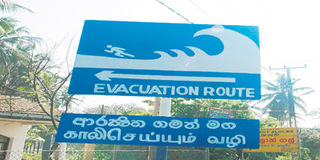How ready are Indian Ocean nations for the next big tsunami?

A tsunami evacuation sign in Sri Lanka. PHOTO | IRIN
What you need to know:
- Today, almost 12 years later, tens of thousands of people from Indian Ocean coastal communities will evacuate their homes in an exercise to establish how prepared the region is for the next “big one”.
On Boxing Day 2004, a 9.2-magnitude earthquake struck off the west coast of Sumatra, triggering a tsunami with a series of waves up to 30 metres (100 feet) high that killed an estimated 230,000 people in 13 countries.
Today, almost 12 years later, tens of thousands of people from Indian Ocean coastal communities will evacuate their homes in an exercise to establish how prepared the region is for the next “big one”.
The two-day drill involves 24 countries, including many of those that suffered the worst devastation in 2004, and will see at least 10 of those carry out a practice evacuation totalling about 50,000 people.
The exercise and subsequent evaluation are an attempt to find out how well the regional tsunami warning system, which began operating in 2011, is working.
“In terms of scale, at least in Indonesia, this is unprecedented,” said Puji Pujiono, a disaster risk reduction advisor with the UN Economic and Social Commission for Asia and the Pacific.
He told IRIN that 3,000 people from various Indonesian agencies are involved, and the drill is being carried out in four districts vulnerable to tsunamis.
“The exercise is meant to test the standard operating procedures and communication links at all levels of the warning chain,” said Andi Eka Sakya, director general of the Indonesian Agency for Meteorology, Climatology and Geophysics, known by its Bahasa acronym BMKG.
He told IRIN the simulation would gauge whether “agencies, community organisations and citizens groups are able to work together to prepare for the evacuation after a tsunami warning is issued by national and local authorities.”
Today’s exercise involves a quake similar to the one in 2004, off the coast of Sumatra. Tomorrow’s will simulate a 9-magnitude earthquake in the Makran Trench in the ocean south of Iran and Pakistan, according to UNESCO, which is responsible for coordinating the tsunami warning system’s governance.
About 7,000 people will be evacuated from 14 Sri Lankan villages, while about 8,000 students will participate in simulated evacuations in Oman. In India, about 35,000 people will take part in evacuations from 350 villages over the next two days.
“Simulating tsunami waves travelling across the Indian Ocean, both exercises will be conducted in real time lasting about 12 hours,” said UNESCO.
Earlier this year, authorities had the opportunity to see the system at work after a magnitude 7.8 quake off Sumatra on 2 March set off warnings in several countries.
In Indonesia, the BMKG sent its first bulletin within five minutes, warning local and regional authorities of the temblor. Ten minutes later it followed up with a tsunami warning bulletin, which was cancelled half an hour later, according to Sakya, the agency’s director general.
That’s the way the warning system is supposed to work at an agency level. On the ground, the response was mixed, Sakya said in a May interview. In some communities the evacuation was orderly, while there was confusion and panic in others.
The writer is IRIN’s Asia Editor




